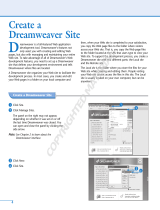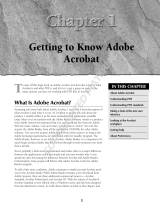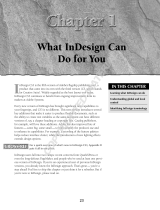Wiley 978-0-470-34518-4 User manual
- Category
- Software manuals
- Type
- User manual
This manual is also suitable for
The Wiley 978-0-470-34518-4 offers advanced features for a seamless user experience. Capture stunning images and videos with its exceptional camera, and immerse yourself in a world of entertainment with its high-resolution display. Stay connected with friends and family through its various communication options, and unleash your creativity with its powerful editing tools. The device’s long-lasting battery ensures uninterrupted use, and its sleek design makes it a stylish companion for everyday tasks and creative endeavors.
The Wiley 978-0-470-34518-4 offers advanced features for a seamless user experience. Capture stunning images and videos with its exceptional camera, and immerse yourself in a world of entertainment with its high-resolution display. Stay connected with friends and family through its various communication options, and unleash your creativity with its powerful editing tools. The device’s long-lasting battery ensures uninterrupted use, and its sleek design makes it a stylish companion for everyday tasks and creative endeavors.
















-
 1
1
-
 2
2
-
 3
3
-
 4
4
-
 5
5
-
 6
6
-
 7
7
-
 8
8
-
 9
9
-
 10
10
-
 11
11
-
 12
12
-
 13
13
-
 14
14
-
 15
15
-
 16
16
Wiley 978-0-470-34518-4 User manual
- Category
- Software manuals
- Type
- User manual
- This manual is also suitable for
The Wiley 978-0-470-34518-4 offers advanced features for a seamless user experience. Capture stunning images and videos with its exceptional camera, and immerse yourself in a world of entertainment with its high-resolution display. Stay connected with friends and family through its various communication options, and unleash your creativity with its powerful editing tools. The device’s long-lasting battery ensures uninterrupted use, and its sleek design makes it a stylish companion for everyday tasks and creative endeavors.
Ask a question and I''ll find the answer in the document
Finding information in a document is now easier with AI
Related papers
-
 Wiley 978-0-471-77618-5 Datasheet
Wiley 978-0-471-77618-5 Datasheet
-
 Wiley 978-0-470-65098-1 Datasheet
Wiley 978-0-470-65098-1 Datasheet
-
 Wiley 978-0-470-05051-4 Datasheet
Wiley 978-0-470-05051-4 Datasheet
-
 Wiley 978-0-470-38252-3 Datasheet
Wiley 978-0-470-38252-3 Datasheet
-
 Wiley 978-0-471-75476-3 Datasheet
Wiley 978-0-471-75476-3 Datasheet
-
 Wiley 978-0-470-48194-3 Datasheet
Wiley 978-0-470-48194-3 Datasheet
-
 Wiley 978-0-4703-8848-8 Datasheet
Wiley 978-0-4703-8848-8 Datasheet
-
 Wiley 978-0-470-13067-4 Datasheet
Wiley 978-0-470-13067-4 Datasheet
-
 Wiley 978-0-470-11938-9 Datasheet
Wiley 978-0-470-11938-9 Datasheet
-
 Wiley 978-0-470-32725-8 Datasheet
Wiley 978-0-470-32725-8 Datasheet
Other documents
-
Adobe 65021175 Datasheet
-
SereneLife Latitude 3580/3588 Owner's manual
-
Dell Latitude 3580/3588 User guide
-
Adobe 65013793 Datasheet
-
Adobe 65022870 - Creative Suite 4 Production Premium User manual
-
Adobe Creative Suite 3 Design Premium User manual
-
Adobe 65113152 Datasheet
-
Adobe 65115830 User manual
-
Adobe Photoshop Elements Owner's manual
-
Adobe Illustrator CS4 Owner's manual

























